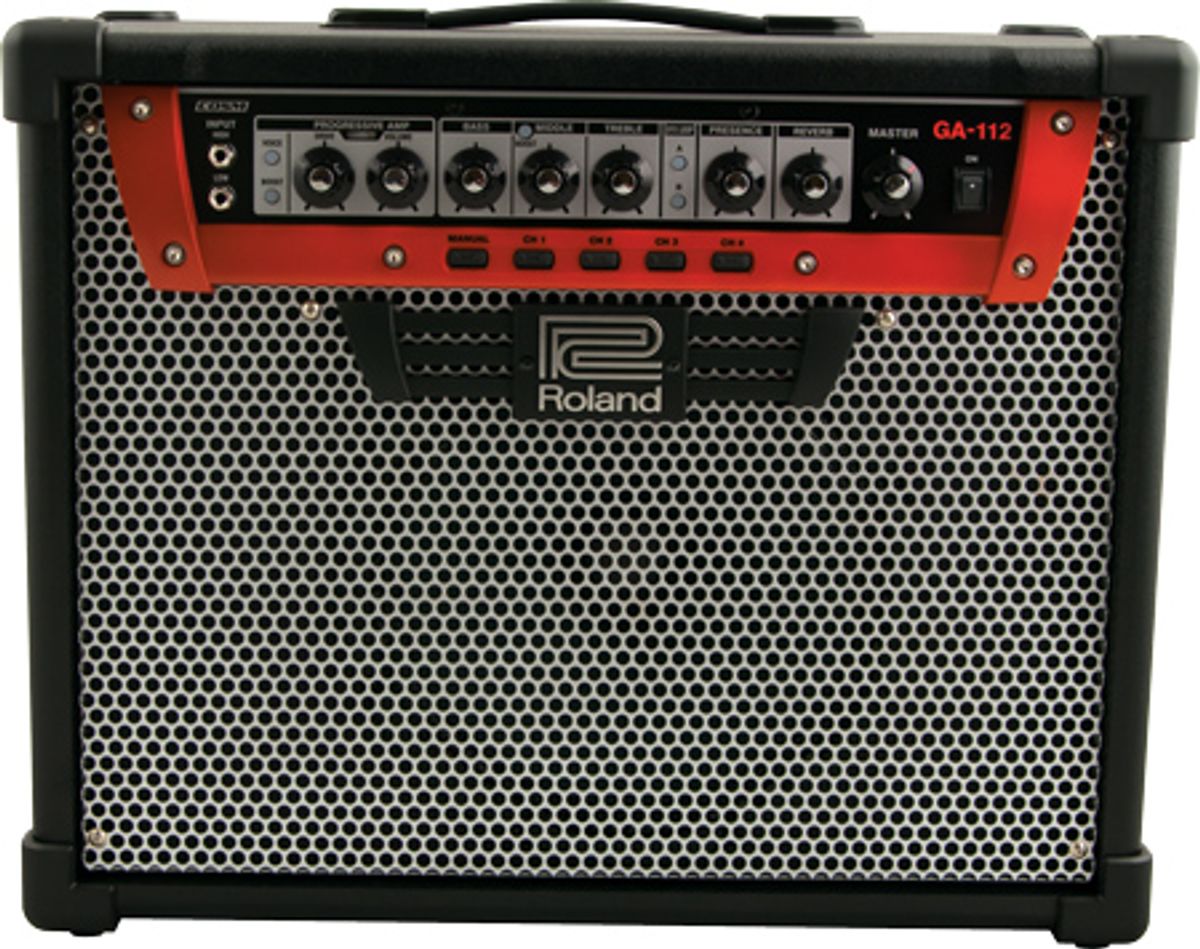
Roland’s new 100-watt GA-112 combo provides a blank slate for sculpting sounds, from pristine clean to metal mayhem via a super-simple control set.
Since the introduction of their Composite Object Sound Modeling [COSM] in 1995, Roland has been active with, and often on the vanguard of modeling technology. Their excellent Cube- and VGA-series amps are among the best examples of how modeling can work convincingly, be practical, and stay accessibly priced. Still, modeling amps are not for everyone. A lot of old-school players remain steadfast in their skepticism, while others associate modeling amps with operational complexity.
Roland’s new flagship GA-series amp, the 100-watt GA-112, may not change the minds of analog devotees. But it certainly simplifies and streamlines things by eschewing effects and relying on a single, but much more flexible and manageable COSM model. Dubbed Progressive Amp, it doesn’t model a particular amp, per se. Instead, it gives you a blank slate for sculpting sounds from pristine clean to metal mayhem via a super-simple control set.
Taking It to the Streets
Other than reverb, the GA-112 has no
effects. In fact, Roland’s Jazz Chorus (introduced
in 1975), with its trademark chorus/
vibrato, has more effects than this COSM
maverick. That said, the GA-112 has two
effects loops that offer series or parallel signal
paths, suggesting an acknowledgement that
most players would prefer to work with their
own effects and pedalboards, thank you.
Rather than control tones via a virtual zoo of EQ and other amp-parameter controls, the Progressive Amp technology works on the very sensible notion that you can create a vast array of sounds—from clean to filthy—with the combination of just a volume and drive control. The end result is an amp that’s barely more complicated than an old Marshall, but very wide-ranging. Apart from the volume and boost controls (grouped with the push buttons for voice and boost in the Progressive Amp section), there’s a bass/middle/treble EQ section, push buttons for mid boost and selecting the A or B effects loop, presence and reverb controls, a master volume, and five push buttons that enable the selection of four presets or manual control. It may feel a little different in practice than a similarly configured tube amp, but the streamlined control set makes navigating the differences a lot easier.
Rollin’ the Range
With the drive almost all the way off,
the GA-112’s clean sounds are pristine
and more than a little reminiscent of my
Roland JC-120. I wouldn’t say the clean
tone is the fattest or warmest around, but
it is an iconic sound that works for everything
from jazz and rapid-fire fusion to
dream pop and shoegaze when you goose
the reverb. And there is a seemingly endless
amount of headroom.
The amp has a small light that changes colors to indicate the drive level, and it went from green to amber when I moved the drive from a clean setting to the midway point, visually indicating my move into low-gain terrain. Maxing the drive at moderate volume levels is the ticket to mid-gain classic rock or blues territory. And at this point, I pressed the voice button, half expecting an entirely different amp model. Instead, it re-voices the EQ section, boosting the highs and lows for a much bolder tone.
Engaging the boost button changes the amp’s character more significantly—transforming the nature of the drive control in a big way. With the boost on and the drive around 9 o’clock, I got just about the same amount of gain as I did with the drive maxed and the boost disengaged. Turning the drive just slightly past the halfway mark yielded a tight, controlled, high-gain sound that’s ideal for classic metal. And when I cranked the drive, I got into hot-rodded Marshall/Soldano SLO territory, a setting that invited thrash chords and blazing licks, and which truly surprised. I’ve never heard or felt a solid-state amp that could pack quite this much punch on its own.
Even with the amp raging, there was still plenty of clarity. Playing complex and harmonically detailed chord voicings found individual notes ringing with impressive crispness. Engaging the mid boost drives beautiful, singing lead tones that are a great companion to the non-mid-boosted rhythm tone—and you could save these two sounds as presets or use the optional footswitch (which unfortunately comes in at a rather steep $119) to activate and deactivate the mid boost.
Save Me
One of my favorite GA-112 features is the
default auto-save function, which automatically
saves settings (there’s also a manual-save
option) to the active channel. For
many programmable amps and effects, having
to press multiple buttons to simply save
a preset is complex enough to be a deterrent.
And I’ve had many units where I had
to refer to the manual to learn that I needed
to press one specific button, while holding
down another, just to save a minor tweak.
In addition to being annoying at home, this
can be downright impractical at a gig. Let’s
say you’ve realized during a soundcheck that
you actually need a little more treble for a
verse, so you move the treble knob quickly
as you held a chord down. Well, on a gig,
you probably wouldn’t have time to save
that adjustment—at least if it involved a
three-step, two-button procedure. Another
common beef with programmable amps is
that the knob indicators generally do not
move when changing from preset to preset.
As a consequence, the settings you see do
not necessarily reflect the setting you hear.
This disconnect has long been a problem,
and while some companies have employed
robotically moving knobs or numerical
LED displays, the GA-112 has red LED
arrows embedded into each knob of the
shared control panel—drive, volume, bass,
middle, treble, presence, and reverb—which
change positions depending on the preset.
It’s clever, it’s simple, and it really helps you
keep your bearings as you get deeper into
the potential of presets.
Ratings
Pros:
Wide range of great sounds. Auto-save and LED equipped
knobs make the amp very practical for live use.
Cons:
Heavy. A little expensive. No included footswitch.
Tones:
Versatility:
Build/Design:
Value:
Street:
$999
Roland
rolandus.com
The Verdict
There’s a ton of processing power under the
hood of the surprisingly heavy (54 pounds)
GA-112. But Roland went to great lengths to
keep things as traditionally amp-like as possible.
As a result, the amp feels familiar, highly
usable, and very navigable. Considering all the
self-contained-rig-type functionality, it's a bit
of a surprise that there's no built-in tuner. In
that small instance, at least, Roland may have
played it too safe.
Trying to walk the line between tradition
and modeling flexibility does leave
the GA-112 with something of an identity
crisis at times. It’s not a full-blown modeling
amp as we’ve come to know them,
but it is much more than just a solid-state
amp. Once you really sit down and play
the GA-112, however, a lot of those questions
go out the window. Most of the time,
it sounded good enough that I didn’t care
whether it was a tube or a digital amp. And
I often got delightfully lost for hours in the
music and remarkable range of tones that
are available via a very traditional-feeling
and simple set of controls. The lack of an
included footswitch—and the almost 120
bucks that you have to pay to get one—is a
bummer, considering that it’s almost essential
to getting the most out of the GA-112
onstage, and that Roland makes much of
the amp’s suitability for that role. But in
delivering this much sound, so simply,
the GA-112 gets most of the way to being
a great-sounding, jack-of-all-trades amp
solution for under a grand—no mean feat
under any circumstances.
